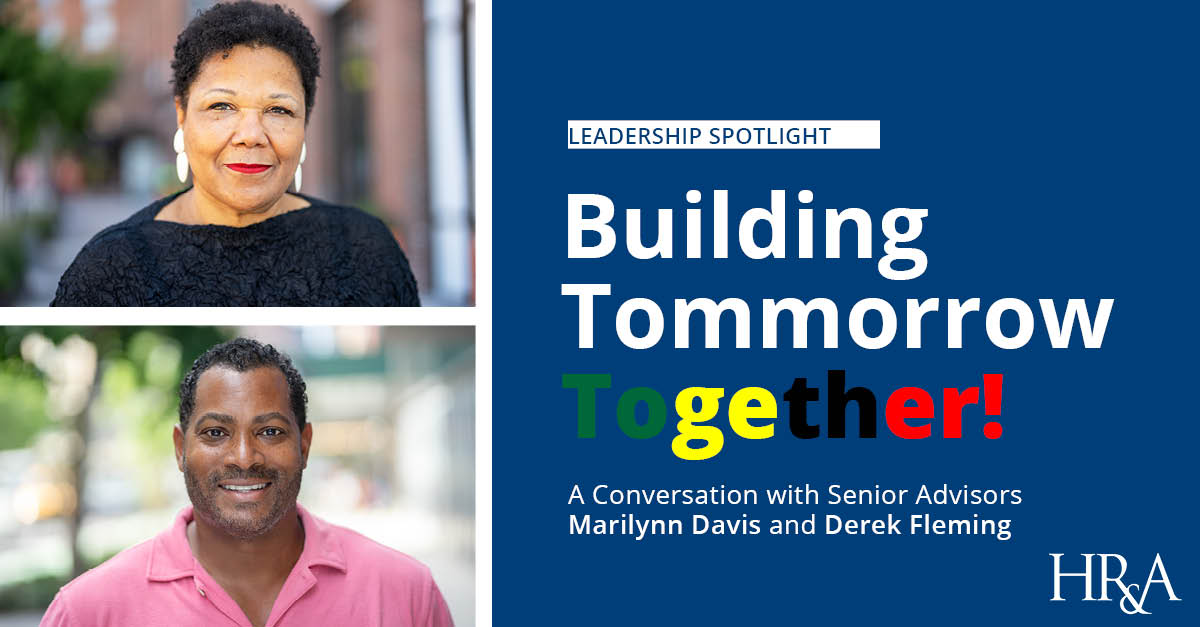We sat down with Senior Advisors Derek Fleming and Marilynn Davis to highlight the industry’s evolution towards genuine inclusion. They discuss the role of public-private partnerships in fostering equity and maximizing public engagement, especially in addressing the needs of Black communities.
There’s a growing recognition among companies regarding the importance of community engagement, especially in underrepresented areas. How do you feel the industry has evolved and are there any noticeable trends towards genuine inclusion?
Marilynn: Community engagement is ingrained in a vast majority of the urban projects we’ve been seeing. It is especially evident in requests from city governments, neighborhood associations, and educational institutions, like urban-based universities. This evolution underscores a fundamental shift in how institutions view their relationship with the communities they serve or are embedded within. At HR&A, we view cities not merely as geographical locations but as dynamic ecosystems, where interactions among diverse components drive growth and vitality.
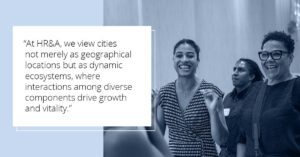
When elements within these ecosystems falter, whether due to shifting dynamics or unhealthy components, the entire system is jeopardized. So, it’s imperative to prioritize community input and address concerns raised by the communities these organizations touch. By incorporating community feedback into projects, organizations can proactively adapt and ensure that developments align with the evolving needs and aspirations of the communities they impact.
Derek: Historically communities of color have been fighting for their voice and enfranchisement, around issues of community policing, educational equity and investment, housing, neighborhood resources and public infrastructure. I remember my dad speaking to me about how during his young adulthood the Black Panthers, SNCC and, NAACP were core national organizations that fought for the upliftment of voices and community engagement, where black and brown communities could be included in the evolution of their neighborhoods.
We still see this tension and gap in community inclusion today. The health, food, and justice disparities glaringly spotlighted during the COVID era, proved to us once again the need for real input, feedback, understanding and agency in the community development process. There needs to be a holistic approach within the development process, where cities, philanthropic organizations, developers, and community development entities collaborate to establish a consensus on the future trajectory of neighborhoods, ensuring benefits for all stakeholders, particularly the folks who live there and our most impacted.
Achieving a comprehensive and inclusive development strategy requires input from all segments of the community. Therefore, community engagement becomes intrinsic to the process. I see it as central to my practice and it’s exciting to know its core tenant of our firm’s mission as we seek equitable development in our engagements.
Do you feel that having that inclusive process leads to better long-standing results?
Derek: I believe we should always seek sustainability in our projects. A holistic, community-centered engagement process heightens the probability of sustainability and depth. Reflecting on HR&A’s longstanding presence, projects like the Atlanta Beltline exemplify our integral role in introducing impactful open spaces to cities. These endeavors not only showcase creative governance structures and innovative financing methods but also prioritize delivering amenities that communities can proudly benefit from for generations. Our current projects echo this ethos, laying the groundwork for enduring structures that champion inclusivity and restoration.
In many instances, our work involves rectifying past disparities in economic empowerment and investment, particularly in black and brown communities. This process embodies a commitment to replenishment, restoration, and respect for Culture, paving the way for sustainable development that transcends surface-level solutions, and looks for authentic ways to include the community in the economics, the equity conversation at hand. I’m inspired knowing that at HR&A, we take pride in our firm’s dedication to projects that transcend fleeting trends, aren’t Band-Aids. It’s refreshing to be part of a team that embraces the challenge of creating lasting change through thoughtful and sustainable urban development practices.
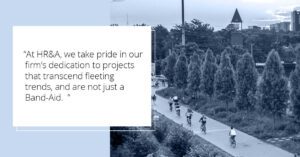
Marilynn: Our work in the knowledge economy sector assist, higher education institutions, and research centers in harnessing their intellectual assets to shape an environment that aligns with their objectives. I was involved in a project where a university hospital was situated in close proximity to a large research institution and public housing. Located in an area ripe for redevelopment, adjacent to underused sites, and near the heart of a city, the project posed multifaceted challenges and opportunities.
Too often disproportionate focus is on research labs and research itself, rather than on a broader set of elements that facilitate it, such as housing, amenities, and community development. A successful innovation hub is not solely for researchers or doctors exclusively; it includes everyone integral to the institution’s functionality. This includes lab technicians and even individuals responsible for maintaining cleanliness, and we saw this in during COVID19 pandemic with essential workers. By prioritizing inclusivity and community engagement,
How do both of you envision the role of public private partnerships evolving to address the needs of black communities in the context of urban development and revitalization efforts?
Derek: Along my real estate journey, I’ve come to appreciate the substantial opportunity and pivotal structure that the public private model represents, particularly when addressing issues of historic disenfranchisement, displacement, lack of intentional, additive investment. Public private approaches along with authentic engagement can go a long way in assuring equitable outcomes. Reflecting on projects like Sweet Auburn in Atlanta underscores the transformative potential when historic communities receive the attention they deserve. Once a vibrant example of black excellence and the birthplace of Martin Luther King Jr., thriving entertainment venues, the nation’s premier black-owned insurance company, the community’s prosperity ended with the onset of desegregation and the forced intrusion of a highway erected into the core of the neighborhood.
Our SAGE project brought us in collaboration with local non-profit organizations tasked with revitalizing this historic district. We established a great partnership. By aligning the interests of public interest groups with those of private developers, we ensure that the community’s voice remains central to the redevelopment process. Our work establishing a governance structure for these organizations to make meaningful decisions alongside private partners fosters a collaborative environment conducive to positive outcomes.
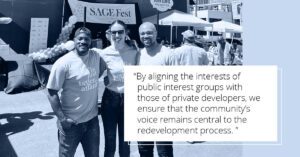
As a result of the work, the neighborhood is empowered to make decisions alongside private developers who want public interest groups to build, and enter the community. They are structured now to operate with capacity, understanding and empowerment alongside the private sector. This synergy between the public and private sectors holds immense promise for creating inclusive and sustainable communities, where a full range of voices are heard and opportunity is shared.
Marilyn: I similarly believe that the scale of challenges cities face will solidify the importance of public-private partnerships (PPPs) . The public sector can leverage its ability to establish a framework that incentivizes private developers and capital to contribute to projects of high value to the community. Cities would benefit from a reward structure that enable the public sector step in and take risks in a way that is difficult for the public sector to do. For instance, establishing entitlement structures, zoning regulations and infrastructure frameworks within a district can advance a shared vision. Additionally, mechanisms such as tax credits and grants can play a pivotal role in stabilizing the financial viability of projects. This is especially pertinent in the current climate, where housing affordability remains a pressing concern nationwide. The framework established by the public sector to facilitate developers’ inclusion of these elements in their projects is important when addressing such challenges effectively.
Where do you see the industry going currently and what are some new opportunities that you’re excited for?
Marilynn: The industry is currently witnessing a profound shift towards large-scale transformative projects that have the potential to revolutionize entire city districts, promising exciting opportunities for urban revitalization. At HR&A, we are deeply involved in endeavors aimed at rectifying historical urban injustices, including those stemming from the misguided urban renewal policies of the past century. As we embrace the burgeoning knowledge economy and strive to harness intellectual assets, cities and nations are increasingly focused on leveraging these assets to shape their built environments.
Derek: What drives me is the evolving understanding and agency within communities, sparked by the wake of COVID-19 and the nationwide reckoning with racial justice. This heightened awareness has fostered an environment of openness and progressiveness, allowing a fertile ground for innovation and creative problem-solving.
As professionals, we now have the opportunity to explore unconventional tools and models, while remaining rooted in tried-and-true approaches. It’s about leveraging public resources, city land, and collaborating across sectors – from the private to the philanthropy- to address complex societal challenges with fresh perspectives. What excites me most is the freedom to approach these issues with creativity, intentionality, and community engagement.
From reimagining food systems to tackling climate change and fostering business ownership opportunities within communities, and building spaces that celebrate the inherent culture, bold conversations are taking place. There’s a shift towards inclusivity and empowerment, particularly for marginalized and historically overlooked communities. It’s about harnessing the rich cultural capital inherent in these communities and transforming it into tangible economic opportunities for those who own it. I’m motivated and excited to continue to push the envelope towards really creative ways of resolving these issues, particularly for communities that have been locked out, marginalized, ill equipped, underinvested and ignored, but have a ton of culture that is actually driving the economies of some of the cities that we’re discussing. The culture of these communities is really a driving force. And so how do we then make sure that that content and that character, that cultural capital becomes an economic opportunity for the people who own it?
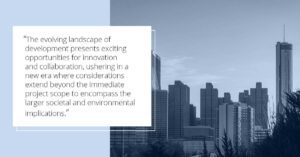
Marilynn: We are at a pivotal juncture where traditional development is undergoing a significant shift. Previously, the development process primarily unfolded within the confines of boardrooms, with input limited from developers, architects, engineers, the client and some city officials. However, this antiquated approach is no longer sufficient. Today, we recognize the need to consider the broader ecosystem and the multifaceted impacts of our projects on the surrounding community. This shift necessitates embracing a more holistic perspective, as highlighted by Derek. The evolving landscape of development presents exciting opportunities for innovation and collaboration, ushering in a new era where considerations extend beyond the immediate project scope to encompass the larger societal and environmental implications.
